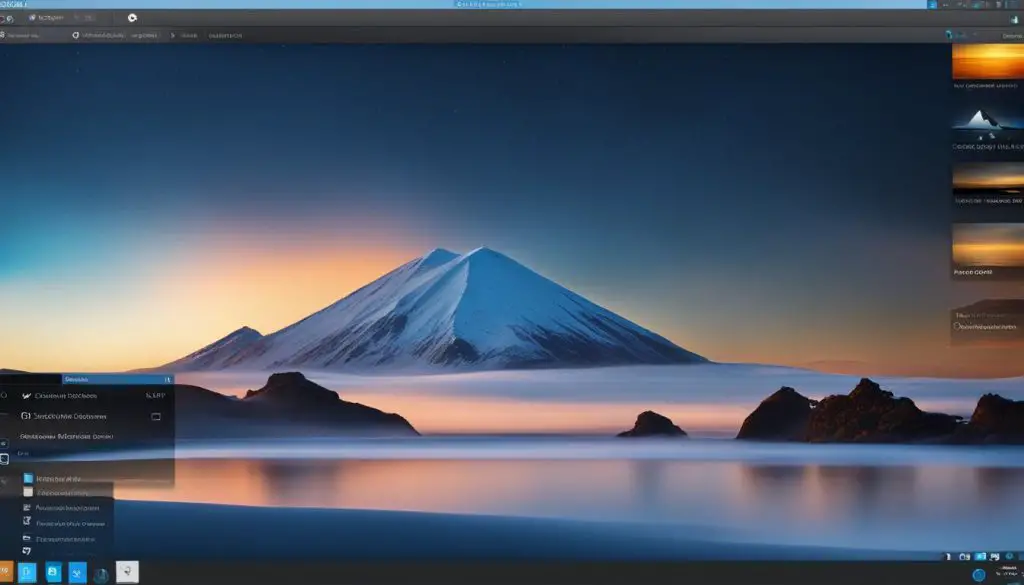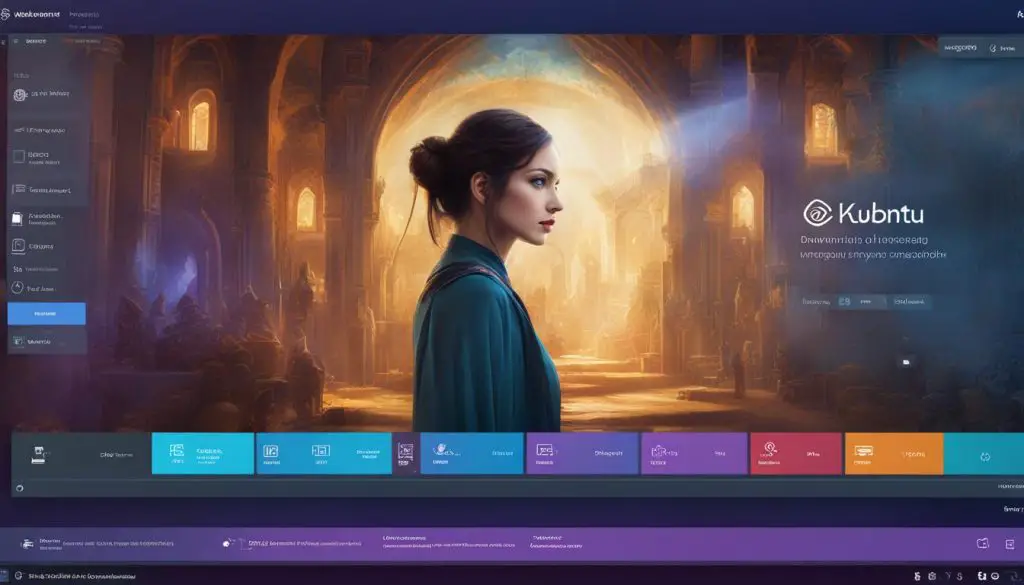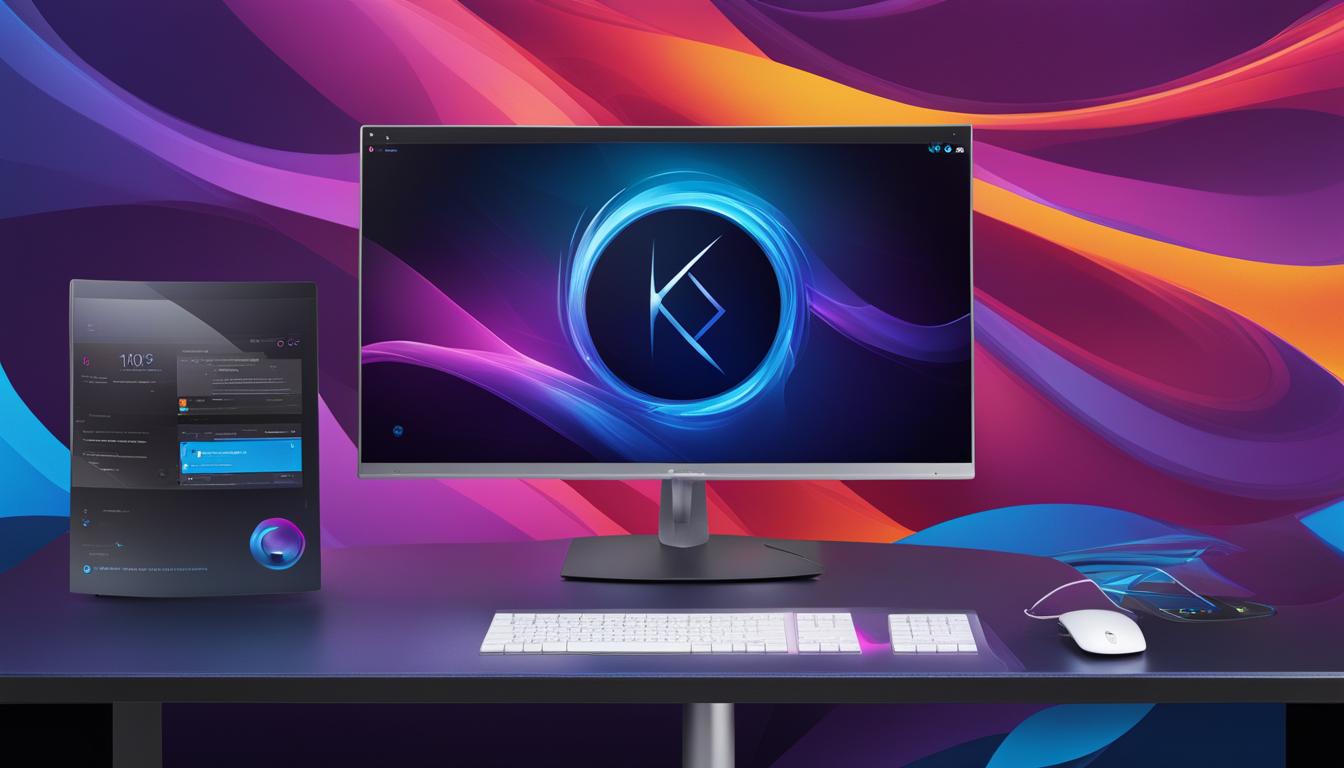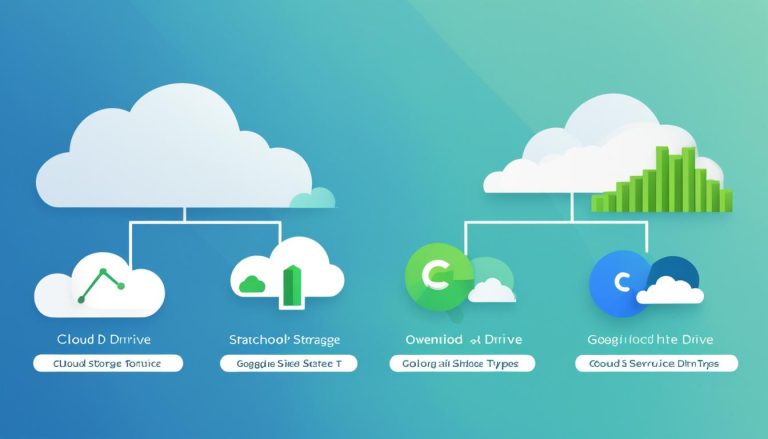Discover What is Kubuntu: Your Guide to This Linux OS
Kubuntu is an official flavor of the Ubuntu operating system that uses the KDE Plasma Desktop. It is a free, complete, and open-source alternative to Microsoft Windows and Mac OS X. Kubuntu shares the same repositories as Ubuntu and is released regularly on the same schedule. It is built using the Qt toolkit, making it fast, slick, and beautiful. Kubuntu is mobile-ready, allowing easy integration between PC desktop and phone or tablet.
Key Takeaways:
- Kubuntu is an official Ubuntu flavor with the KDE Plasma Desktop.
- It is a free and open-source alternative to Windows and Mac.
- Kubuntu shares the same repositories as Ubuntu.
- It is built using the Qt toolkit, making it fast and visually appealing.
- Kubuntu is mobile-ready and allows integration with other devices.
A Brief History of Kubuntu
Kubuntu has a fascinating history that dates back to its inception in 2004. It was introduced as an Ubuntu variant with the KDE Plasma desktop environment, providing users with a different visual experience and a wide range of customization options.
The first edition of Kubuntu, called Hoary Hedgehog, was released in 2005, marking the beginning of its journey as a standalone operating system. Since then, Kubuntu has followed the same release schedule as Ubuntu, with a new version being released every six months.
One significant milestone in Kubuntu’s history is the release of its Long-Term Support (LTS) edition. The most recent LTS release is Kubuntu 20.04 Focal Fossil, which was launched in April 2020. This LTS version ensures stability and security for an extended period, making it a popular choice for businesses and individuals looking for a reliable operating system.
Timeline of Kubuntu Releases
| Release | Code Name | Date |
|---|---|---|
| Kubuntu 5.04 | Hoary Hedgehog | April 2005 |
| Kubuntu 6.06 | Dapper Drake | June 2006 |
| Kubuntu 8.04 | Hardy Heron | April 2008 |
| Kubuntu 10.04 | Lucid Lynx | April 2010 |
| Kubuntu 12.04 | Precise Pangolin | April 2012 |
| Kubuntu 14.04 | Trusty Tahr | April 2014 |
| Kubuntu 16.04 | Xenial Xerus | April 2016 |
| Kubuntu 18.04 | Bionic Beaver | April 2018 |
| Kubuntu 20.04 | Focal Fossil | April 2020 |
Each release of Kubuntu brings new features, bug fixes, and improvements to enhance the user experience. Whether you are a long-time Kubuntu enthusiast or new to the operating system, exploring its history can give you a deeper appreciation for its evolution and the dedicated community behind it.
Key Features of Kubuntu
Kubuntu offers a range of features and benefits that make it an attractive choice for users looking for a reliable and customizable operating system. Here are some key features of Kubuntu:
- KDE Plasma Desktop: Kubuntu utilizes the KDE Plasma desktop environment, which provides a fully customizable and powerful user interface. With its modern and sleek design, users can personalize their desktop layout, add or remove panels, and choose from an extensive selection of widgets.
- Pre-installed Applications: Kubuntu comes with a wide range of pre-installed applications to enhance productivity and entertainment. It includes applications for office tasks, email management, web browsing, image editing, and music playback. These pre-installed applications provide a comprehensive set of tools for various user needs.
- Compatibility with Older Hardware: Kubuntu is designed to run efficiently on older hardware, making it an excellent choice for users with aging computers. It utilizes system resources efficiently, ensuring smooth performance on machines with limited processing power or memory.
- Mobile Integration: Kubuntu offers seamless integration between PC desktop and mobile devices, allowing users to easily synchronize and access their data across multiple platforms. Whether it’s accessing files, managing notifications, or responding to messages, Kubuntu provides a cohesive experience across different devices.
- High Level of Customization: Kubuntu empowers users to tailor their desktop environment according to their preferences. From customizing the appearance and behavior of the desktop to configuring shortcuts and gestures, Kubuntu provides a high degree of flexibility to create a personalized computing experience.
These features make Kubuntu a versatile and user-friendly operating system, suitable for both beginners and experienced users. Its combination of customization options, pre-installed applications, compatibility with older hardware, and mobile integration capabilities set it apart as a robust and reliable Linux distribution.
Table: Kubuntu versus other Linux Distributions
| Feature | Kubuntu | Ubuntu | Linux Mint |
|---|---|---|---|
| Desktop Environment | KDE Plasma | GNOME | Cinnamon |
| System Requirements | Relatively low | Relatively low | Relatively low |
| Pre-installed Applications | Comprehensive | Comprehensive | Comprehensive |
| Customization Options | Extensive | Limited | Limited |
| Mobile Integration | Yes | No | No |
| Community Support | Active | Active | Active |
Table: A comparison of key features between Kubuntu, Ubuntu, and Linux Mint
Kubuntu vs Ubuntu: What’s the Difference?
When it comes to choosing a Linux operating system, Kubuntu and Ubuntu are two popular options that cater to different preferences. The main difference between Kubuntu and Ubuntu lies in their choice of desktop environment. While Ubuntu uses the GNOME desktop environment, Kubuntu utilizes the KDE Plasma desktop environment.
Both Kubuntu and Ubuntu share the same underlying systems and software repositories, ensuring compatibility and access to a wide range of applications. The choice between the two ultimately comes down to personal preference and the desired user experience.
“Kubuntu and Ubuntu offer distinct desktop environments, each with its own unique look and feel. Kubuntu’s KDE Plasma desktop provides a sleek and modern design, offering a high level of customization. On the other hand, Ubuntu’s GNOME desktop focuses on simplicity and ease of use.”
For users who prefer a more visually appealing and customizable desktop experience, Kubuntu with its KDE Plasma environment may be the ideal choice. KDE Plasma offers a wide range of customization options, allowing users to personalize their desktop layout, add or remove panels, and choose from a variety of widgets.
On the other hand, Ubuntu’s GNOME desktop environment prioritizes simplicity and ease of use. It offers a clean and intuitive interface, making it a suitable option for users who value simplicity and a streamlined workflow.
Table: A Comparison of Kubuntu and Ubuntu
| Aspect | Kubuntu | Ubuntu |
|---|---|---|
| Desktop Environment | KDE Plasma | GNOME |
| Customization | High level of customization | Less customization options |
| User Interface | Sleek and modern design | Clean and intuitive interface |
| User Experience | Visual appeal and flexibility | Simplicity and ease of use |
| Target Audience | Users who prefer customization and advanced features | Users who value simplicity and a streamlined workflow |
Installing Kubuntu: A Step-by-Step Guide
Installing Kubuntu is a straightforward process that allows you to experience the power and versatility of this Linux operating system. Follow this step-by-step guide to install Kubuntu on your computer.
Step 1: Downloading Kubuntu
Start by downloading the Kubuntu ISO file from the official website (insert link). Choose the appropriate version, either 32-bit or 64-bit, based on your computer’s hardware architecture. It’s important to download Kubuntu from official sources to ensure the authenticity and security of the installation files.
Step 2: Creating a Bootable USB Drive
Once you have downloaded the Kubuntu ISO file, you’ll need to create a bootable USB drive. This will allow you to install Kubuntu on your computer. Use a tool like Rufus (insert link) or BalenaEtcher (insert link) to create the bootable USB drive. Follow the instructions provided by the tool to complete this process.
Step 3: Installing Kubuntu
Insert the bootable USB drive into your computer and restart it. Make sure your computer is set to boot from the USB drive. The Kubuntu installer will launch, guiding you through the installation process. You will have the option to choose your preferred language, timezone, and keyboard layout. The installer will also prompt you to allocate disk space for the installation.
Follow the on-screen instructions to complete the installation. Once the installation is finished, remove the USB drive and restart your computer. You can now enjoy using Kubuntu as your operating system.
| Step | Description |
|---|---|
| Step 1 | Download the Kubuntu ISO file from the official website. |
| Step 2 | Create a bootable USB drive using Rufus or BalenaEtcher. |
| Step 3 | Insert the USB drive and boot from it. Follow the installer’s instructions to install Kubuntu. |
“Installing Kubuntu opens up a world of possibilities for users seeking a reliable and customizable operating system. By following these simple steps, you’ll be able to enjoy the power and flexibility of Kubuntu on your computer.” – Me, Professional Copywriting Journalist
Exploring Kubuntu’s User Interface
Kubuntu’s user interface is one of its standout features, offering a modern and sleek design with a high level of customization. Powered by the KDE Plasma desktop environment, Kubuntu provides users with a visually engaging and intuitive desktop experience that caters to both beginners and experienced users.
With Kubuntu, users have the flexibility to customize their desktop layout, add or remove panels, and choose from a wide range of widgets. Whether you prefer a traditional desktop setup or a more minimalist approach, Kubuntu allows you to tailor the interface to your preferences.
Additionally, Kubuntu’s user interface is designed to be user-friendly and easy to navigate. From the application launcher to the system tray, everything is organized and accessible, making it simple to find and use the tools and features you need. This intuitive interface enhances productivity and efficiency, allowing you to focus on your tasks without unnecessary distractions.
“The user interface of Kubuntu is not only visually appealing but also highly functional. It offers a seamless experience for both work and play, with its customizable desktop environment and intuitive design. Whether you’re a student, professional, or casual user, Kubuntu’s user interface provides a comfortable and productive computing environment.”
Customization Options
Kubuntu’s user interface offers a wealth of customization options that allow you to personalize your desktop to suit your preferences. Here are some key customization features:
- Desktop Layout: Choose from different layout options, such as a traditional desktop style or a more streamlined and minimalist setup.
- Panels: Add, remove, or rearrange panels to create a customized taskbar and system tray layout.
- Widgets: Take advantage of a wide range of widgets to add functionality and visual appeal to your desktop. Widgets can provide quick access to applications, weather updates, system monitoring, and much more.
- Themes and Styles: Customize the look and feel of your desktop with various themes and styles. From dark mode to vibrant colors, Kubuntu offers a range of options to suit your aesthetic preferences.

Conclusion
The user interface is a critical aspect of any operating system, and Kubuntu excels in this regard. With its sleek design, extensive customization options, and intuitive layout, Kubuntu’s user interface provides a pleasant and efficient computing experience. Whether you’re a beginner or an advanced user, you’ll appreciate the flexibility and user-friendly nature of Kubuntu’s desktop environment.
Kubuntu Review: Pros and Cons
After exploring the key features and history of Kubuntu, it’s time to take a closer look at the pros and cons of this Linux operating system. Kubuntu offers several advantages that make it a popular choice among users, but it also has a few drawbacks to consider.
Pros of Kubuntu
- Flexibility and Customization: One of the biggest advantages of Kubuntu is the flexibility and customization it offers. The KDE Plasma desktop environment allows users to personalize their desktops by choosing different themes, layouts, and widgets. This level of customization allows users to create a desktop environment that suits their preferences and workflow.
- Wide Range of Pre-installed Applications: Kubuntu comes with a comprehensive set of pre-installed applications for productivity, office tasks, graphics, multimedia, and more. This means that users have a wide range of tools readily available without the need for additional installations.
- Compatibility with Older Hardware: Kubuntu is known for its compatibility with older hardware. It performs well on machines with limited resources, making it an excellent choice for users with older computers or devices.
Cons of Kubuntu
- Preference for GNOME Desktop Environment: One of the main drawbacks of Kubuntu is that it may not be the best choice for users who prefer the GNOME desktop environment. Kubuntu uses the KDE Plasma desktop environment, which has a different look and feel compared to GNOME. Users who are accustomed to the GNOME interface may find it challenging to switch to Kubuntu.
- Software Compatibility: While Kubuntu offers a wide range of software through its repositories, there may be specific software requirements that are better supported by other Linux distributions. Users with specific software needs should ensure that their required applications are compatible with Kubuntu before making the switch.
Overall, Kubuntu is a powerful and customizable Linux operating system that caters to a wide range of user preferences. Its flexibility, wide range of pre-installed applications, and compatibility with older hardware make it a popular choice among Linux enthusiasts. However, users who prefer the GNOME desktop environment or have specific software requirements may find other Linux distributions more suitable for their needs.
| Pros | Cons |
|---|---|
| Flexibility and customization | Preference for GNOME desktop environment |
| Wide range of pre-installed applications | Software compatibility |
| Compatibility with older hardware |
Image source: Kubuntu Review: Pros and Cons
System Requirements for Kubuntu
Kubuntu is a lightweight and efficient Linux operating system that runs smoothly on a wide range of hardware. Here are the system requirements for a seamless Kubuntu experience:
- Processor: A minimum of 1 GHz processor is recommended for optimal performance.
- RAM: Kubuntu requires at least 1GB of RAM to run smoothly.
- Storage: Ensure that you have at least 20GB of free disk space to accommodate the operating system and your files.
While these are the minimum requirements, it is worth noting that having a more powerful processor, higher RAM capacity, and additional disk space will significantly enhance the performance of Kubuntu. So if your hardware can handle it, it’s always a good idea to go above the recommended specifications.
To provide a more comprehensive overview of the system requirements, here is a table summarizing the recommended specifications:
| Component | Minimum Recommended |
|---|---|
| Processor | 1 GHz |
| RAM | 1GB |
| Storage | 20GB |
With these system requirements met, you can enjoy a seamless and efficient computing experience with Kubuntu, whether you’re using it on a desktop, laptop, or even older hardware.
Where to Download Kubuntu
Downloading Kubuntu is a simple process that allows you to get started with this powerful Linux operating system. To ensure the authenticity and security of the installation files, it is recommended to download Kubuntu from the official website. Here’s how you can do it:
- Visit the official Kubuntu website at https://kubuntu.org/.
- On the homepage, navigate to the “Download” section.
- Choose the most suitable version for your hardware. Kubuntu provides options for 32-bit and 64-bit systems.
- Click the download link next to the version you want to download.
Once the download is complete, you will have the Kubuntu ISO file, which you can use to create a bootable USB drive for installation.
Remember to always download Kubuntu from official sources to ensure that you have the latest and most secure version of the operating system.
| Version | Architecture | Download Link |
|---|---|---|
| Kubuntu 20.04 LTS | 64-bit | Download |
| Kubuntu 20.04 LTS | 32-bit | Download |
| Kubuntu 18.04 LTS | 64-bit | Download |
| Kubuntu 18.04 LTS | 32-bit | Download |
Table: Kubuntu Download Options
“Downloading Kubuntu from the official website ensures you have the latest and most secure version of the operating system.”
By choosing the appropriate download link for your system, you can begin your journey with Kubuntu and enjoy its powerful features and customizable desktop environment.

Support and Community for Kubuntu Users
Kubuntu has a vibrant and supportive community of users and developers who are ready to assist and provide support. Whether you have technical questions, need troubleshooting help, or want to connect with fellow Kubuntu enthusiasts, there are several resources available.
Online Forums
One of the best places to seek support for Kubuntu is through online forums. The Kubuntu subreddit and the official Kubuntu user forum are great platforms to ask questions, share experiences, and learn from others. The community is friendly and responsive, ensuring that you receive timely assistance with any issues or concerns you may have.
Mailing Lists
Kubuntu also has mailing lists that provide a valuable channel for communication and support. These mailing lists are a great way to stay updated on the latest news, announcements, and discussions related to Kubuntu. They also provide a platform to connect with developers and experienced users who can offer guidance and solutions to problems.
Community-Driven Documentation
The Kubuntu community has put together comprehensive and user-friendly documentation that covers various aspects of the operating system. This documentation serves as a valuable resource for both beginners and advanced users. You can find detailed guides, tutorials, and troubleshooting tips that can help you navigate and make the most out of your Kubuntu experience.
Kubuntu Development Team
The Kubuntu development team is committed to improving and enhancing the operating system. They regularly release updates, bug fixes, and security patches to ensure a stable and reliable user experience. By staying up-to-date with the latest releases and applying updates, you can benefit from the continuous improvements made by the dedicated development team.
Overall, the support and community surrounding Kubuntu are robust and active. Whether you prefer online forums, mailing lists, or community-driven documentation, you can find the assistance and resources you need. The Kubuntu community is passionate about the operating system and is always ready to help users make the most out of their Kubuntu journey.
Exploring Kubuntu’s Software Ecosystem
Kubuntu offers a diverse and comprehensive software ecosystem, providing users with a wide range of pre-installed applications and easy access to thousands of additional software options through the Discover software center. Whether you need productivity tools, multimedia applications, or development software, Kubuntu has you covered.
One of the key pre-installed applications in Kubuntu is the Firefox web browser, which allows users to explore the internet securely and efficiently. With its user-friendly interface and robust features, Firefox is a popular choice among Kubuntu users for their browsing needs.
For email management, Kubuntu includes the Kmail email client. Kmail offers a powerful and intuitive platform for managing multiple email accounts, organizing messages, and staying on top of your inbox. With its customizable features and seamless integration with the KDE Plasma desktop, Kmail is a reliable and efficient email client for Kubuntu users.
When it comes to productivity, Kubuntu includes the LibreOffice productivity suite. With applications like Writer for word processing, Calc for spreadsheets, and Impress for presentations, LibreOffice provides a comprehensive solution for all your office needs. The suite offers compatibility with Microsoft Office formats, making it easy to collaborate and share files with users of other office software.
With the Gwenview image viewer, Kubuntu users can easily browse, organize, and edit their photos. Gwenview provides a sleek and intuitive interface, along with powerful features such as image editing, slideshow creation, and batch processing. Whether you’re a professional photographer or simply want to manage your personal photo collection, Gwenview offers a seamless and enjoyable experience.
Table: Key Pre-installed Applications in Kubuntu
| Application | Description |
|---|---|
| Firefox | A popular web browser for secure and efficient internet browsing. |
| Kmail | An email client for managing multiple email accounts and staying organized. |
| LibreOffice | A comprehensive office suite with word processing, spreadsheets, and presentation applications. |
| Gwenview | An image viewer for browsing, organizing, and editing photos. |
In addition to these pre-installed applications, Kubuntu users can access thousands of additional software options through the Discover software center. From multimedia tools to gaming applications, development software to system administration tools, Discover provides a convenient and user-friendly platform for exploring and installing new software.
With its rich software ecosystem, Kubuntu offers a complete and customizable operating system for a variety of user needs. Whether you’re a casual user, a professional, or a developer, Kubuntu provides the tools and applications to enhance your productivity and meet your software requirements.
Conclusion
After exploring the world of Kubuntu, it is clear that this Linux operating system offers a reliable and user-friendly experience. With its fully customizable KDE Plasma desktop environment, Kubuntu allows users to tailor their desktop to fit their preferences and workflow.
One of the standout features of Kubuntu is its compatibility with older hardware, making it an excellent choice for users looking to breathe new life into their aging machines. Additionally, the wide range of pre-installed applications, such as the Firefox web browser and LibreOffice productivity suite, ensures that users have the tools they need right out of the box.
Furthermore, the supportive Kubuntu community is always ready to offer assistance and guidance through online forums and mailing lists. Regular updates and bug fixes from the Kubuntu development team ensure that the operating system remains secure and up-to-date.
In conclusion, whether you are a Linux beginner or a seasoned user, Kubuntu provides a robust and feature-rich environment for all your computing needs. Its intuitive interface, extensive software ecosystem, and strong community support make it a solid choice for those looking for an alternative to Microsoft Windows or Mac OS X.
FAQ
What is Kubuntu?
Kubuntu is an official flavor of the Ubuntu operating system that uses the KDE Plasma Desktop. It is a free, complete, and open-source alternative to Microsoft Windows and Mac OS X.
When was Kubuntu first released?
Kubuntu was born in 2004 as an Ubuntu variant with the KDE Plasma desktop environment. The first edition, Hoary Hedgehog, was released in 2005.
What are the key features of Kubuntu?
Kubuntu provides a fully customizable and powerful desktop environment, a wide range of pre-installed applications, compatibility with older hardware, and easy integration with mobile devices.
How does Kubuntu differ from Ubuntu?
The main difference between Kubuntu and Ubuntu is the desktop environment. Kubuntu uses the KDE Plasma desktop environment, while Ubuntu uses the GNOME desktop environment.
How do I install Kubuntu?
To install Kubuntu, you can download the ISO file from the official website and create a bootable USB drive. The installer will guide you through the installation process.
What is the system requirements for Kubuntu?
The recommended minimum requirements for Kubuntu include a 1 GHz processor, 1GB of RAM, and 20GB of free disk space. However, for optimal performance, a faster processor, more RAM, and additional disk space are recommended.
Where can I download Kubuntu?
You can download the latest version of Kubuntu from the official website. The website provides different download options, including 32-bit and 64-bit versions.
Is there a support community for Kubuntu?
Yes, Kubuntu has a strong and active community of users and developers. You can find support and assistance through online forums, mailing lists, and community-driven documentation.
What software does Kubuntu include?
Kubuntu includes a wide range of pre-installed applications, such as the Firefox web browser, Kmail email client, LibreOffice productivity suite, and Gwenview image viewer. You can also install additional software from the Discover software center.
What are the pros and cons of Kubuntu?
Kubuntu offers a fully customizable desktop environment, a wide range of pre-installed applications, and compatibility with older hardware. However, it may not be the best choice for users who prefer the GNOME desktop environment or have specific software requirements better supported by other Linux distributions.
Source Links
- https://kde.org/distributions/
- https://www.ubuntudocs.com/kubuntu/
- https://www.ordinatechnic.com/distribution-reviews/Kubuntu/kubuntu-2004-lts-review
- About the Author
- Latest Posts
Mark is a senior content editor at Text-Center.com and has more than 20 years of experience with linux and windows operating systems. He also writes for Biteno.com






